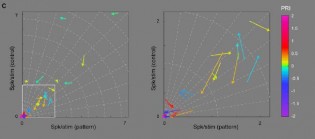The paper entitled Pattern-sensitive neurons reveal encoding of complex auditory regularities in the rat inferior colliculus, co-authored by Carles Escera and carried out in collaboration with Prof. Manuel S. Malmierca and his team at the University of Salamanca (Spain), has been published in Neuroimage.
In this further study from the ongoing collaboration between the Brainlab and the Auditory Neurophysiology Lab of the University of Salamanca, Malrmierca et al. show on the existence of a particular set of neurons in the inferior colliculus of the rat that show pattern–sensitive responses. In their experiments, Malmierca and colleagues presented rats with sequences of tones conforming to pattern alternations, and compared the responses of individual neurons in the inferior colliculus with those to stimuli in which occasional sound repetitions violated the alternation. We found that some neurons in the IC were sensitive to the history of patterned stimulation and to violations in patterned regularity. These results indicate that neurons in the subcortical auditory system can compute complex contingencies among discrete auditory events, and contribute to our model on the hierarchical organization of the auditory novelty system (Escera & Malmierca, 2014).

The full abstract reads as follows:
A ‘pattern alternation paradigm’ has been previously used in human ERP recordings to investigate the brain encoding of complex auditory regularities, but prior studies on regularity encoding in animal models to examine mechanisms of adaptation of auditory neuronal responses have used primarily oddball stimulus sequences to study stimulus-specific adaptation alone. In order to examine the sensitivity of neuronal adaptation to expected and unexpected events embedded in a complex sound sequence, we used a similar patterned sequence of sounds. We recorded single unit activity and compared neuronal responses in the rat inferior colliculus (IC) to sound stimuli conforming to pattern alternation regularity with those to stimuli in which occasional sound repetitions violated that alternation. Results show that some neurons in the rat inferior colliculus are sensitive to the history of patterned stimulation and to violations of patterned regularity, demonstrating that there is a population of subcortical neurons, located as early as the level of the midbrain, that can detect more complex stimulus regularities than previously supposed and that are as sensitive to complex statistics as some neurons in primary auditory cortex. Our findings indicate that these pattern-sensitive neurons can extract temporal and spectral regularities between successive acoustic stimuli. This is important because the extraction of regularities from the sound sequences will result in the development of expectancies for future sounds and hence, the present results are compatible with predictive coding models. Our results demonstrate that some collicular neurons, located as early as in the midbrain level, are involved in the generation and shaping of prediction errors in ways not previously considered and thus, the present findings challenge the prevailing view that perceptual organization of sound only emerges at the auditory cortex level.
Full reference:
Malmierca, M.S., Niño-Aguillón, B., Nieto-Diego, J., Porteros, A., Pérez-Gonzálex, D., & Escera, C. (2018). Pattern-sensitive neurons reveal encoding of complex auditory regularities in the rat inferior colliculus. Neuroimage, in press.

